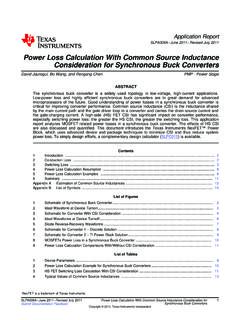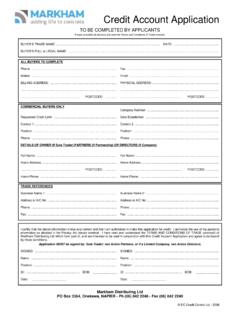Transcription of LAW FIRM FINANCIAL REPORTING
1 LAW FIRM FINANCIAL REPORTING A. How Many Reports Could One Person Need? Today s time/billing/accounting programs have so many reports available to users, it can be incredibly overwhelming. One of the clinchers, not to harp on the integrated accounting issue, is that there is no better way to ensure accuracy in your reports than to do everything related to the back office of your law firm in one program. In all of the popular billing programs for law firms, when you look at the reports menu, there are literally hundreds of different report combinations. Many reports can be sorted and totaled in many different ways, and those kinds of things can drastically change the results of the report. The reports are typically sorted in to several categories. B. Different Types of Reports: 1. Productivity: Productivity reports are used to assess many things, such as hours worked, hours billed, collections, matters opened and many other relevant statistics to help you gauge the effectiveness of a timekeeper.
2 One of the things to be cognizant of are the write-ups/downs and write-offs. Each software product will have different report names and slightly different options, but we have included below some screenshots of different productivity and time summary report examples from some of the more popular small firm TBA products, PCLaw and Tabs3. a. Collection Summary: A report like this is a great combination report. You can see the number of hours billed, the amount of fees billed, cash collected, how collections were allocated, and A/R balances. All of this is run so you can analyze month by month, attorney by attorney. 2. Billing: After your bills are run, wouldn t you like a quick, easy way to see what bills just went in the mail? You can see total fees billed, costs billed and also see the totals summarized by the person who did the work (or by responsible attorney, etc.)
3 3. Collections: Many law firms pay their attorneys based on the fees collected. This report is going to show all payments received and see how the cash in relates to the person who did the work. 4. FINANCIAL : Even if you don t want the gory details, it makes sense for you to look at a summary of your FINANCIAL situation at least weekly. Here is a summary of what that can look like. In a nutshell you need to make sure that the cash you have on hand and what is coming in are going to exceed what is going out. Not all of the software products will amalgamate this into one Cash Flow report for you, but here is a sample of what you may want to review. a. Cash on hand gives you the balance in your cash accounts, not including trust b. Accounts Receivable lets you know what money is due to come in during the next 30 days, and makes you aware of what your old receivable balance is c.
4 Payables Your payables total plus your next payroll total together is the forecasted amount of cash you will need available d. Work in Progress WIP includes all time and fees that have not yet been billed e. Billing month-to-date Gives you an idea of what bills have gone out from the first of the month to this report date, broken down by fees and costs f. Payroll Gives you the next payroll date plus the estimated amount for cash planning g. Balance on LOC Here you can track any short term liabilities Keep in mind, this is just an example. You can include anything you want to see on this report. This is a good option for you if you do not want to see the details each week, you can get this on Fridays and then once or twice a month, get the reports that give you the detail to these numbers. Of course, if any number looks out of whack, you can request the detailed reports to support the numbers. C. Your FINANCIAL Statements: The discussion about your FINANCIAL statements refers to 2 main reports.
5 Your balance sheet and your income statement (aka Profit & loss ). Basically, your balance sheet should show what you own (your assets), what you owe (your liabilities), and any equity value you have in your law firm. Your income statement is going to show total income minus total expenses giving you a net income. The balance sheet totals carry forward from year to year, while the income statement starts over each year. It is important to understand that those two reports are very closely related. There is a line item on your balance sheet that is called Net Income or Retained Earnings , and that number represents revenue less expenses. So any change you make to the income statement will affect the balance sheet. A trial balance is a consolidated FINANCIAL statement that basically combines both the balance sheet and the income statement onto one report so that everything can be seen together.
6 Each transaction you make in your accounting system results in 2 or more equalizing entries, referred to as debits and credits. The debits and credits for any transaction must equal one another. As an example, if you write a check to pay your rent, the resulting transaction is a credit to cash (which is an asset, or something you own, therefore reported on your balance sheet) and a debit to the expense account called rent (which is an expense, and therefore reported on your income statement). If you review a balance sheet before that transaction, and then after, you will see that the cash balance changes and the net income changes. On the income statement, the total rent paid changes and the net income changes. Here is a little more detail on those 2 reports: 1. Balance Sheet: A balance sheet is a snapshot of a your law firm s FINANCIAL condition at a specific moment in time, usually at the close of an accounting period.
7 A balance sheet comprises assets, liabilities, and owners or stockholders equity. Assets and liabilities are divided into short- and long-term obligations including cash accounts such as checking, money market, or government securities. At any given time, assets must equal liabilities plus owners equity. An asset is anything the business owns that has monetary value. Liabilities are the claims of creditors against the assets of the business. Balance sheets, along with income statements, are the most basic elements in providing FINANCIAL REPORTING to potential lenders such as banks, investors, and vendors who are considering how much credit to grant the firm. a. Assets: Assets are subdivided into current and long-term assets to reflect the ease of liquidating each asset. Cash, for obvious reasons, is considered the most liquid of all assets. Long-term assets, such as real estate or machinery, are less likely to sell overnight or have the capability of being quickly converted into a current asset such as cash.
8 B. Current assets: Current assets are any assets that can be easily converted into cash within one calendar year. Examples of current assets would be checking or money market accounts, accounts receivable, and notes receivable that are due within one year s time. Although accounts receivable is a common thing to see on balance sheets, most law firms do not include that as a balance sheet item because they are run on a cash basis. Simply put, when you run your business on a cash basis, you do not count income until you receive the cash, so billing has no effect on accounting. i. Cash - Money available immediately, such as in checking accounts, is the most liquid of all short-term assets. ii. Notes receivables - Notes receivables that are due within one year are current assets. Notes that cannot be collected on within one year should be considered long-term assets.
9 C. Fixed assets: Fixed assets include land, buildings, machinery, and vehicles that are used in connection with the business. i. Land - Land is considered a fixed asset but, unlike other fixed assets, is not depreciated, because land is considered an asset that never wears out. ii. Buildings - Buildings are categorized as fixed assets and are depreciated over time. iii. Office equipment - This includes office equipment such as copiers, printers, servers, computers, etc. used in your business. iv. Vehicles - This would include any vehicles used in your business. v. Total fixed assets - This is the total dollar value of all fixed assets in your business, less any accumulated depreciation. d. Total assets: This figure represents the total dollar value of both the short-term and long-term assets of your business. e. Liabilities and owners equity: This includes all debts and obligations owed by the business to outside creditors, vendors, or banks that are payable within one year, plus the owners equity.
10 Often, this side of the balance sheet is simply referred to as Liabilities. Again, because most law firms run on a cash basis, Accounts Payable will not appear on a balance sheet. Expenses are not counted as expenses until the bills are paid. i. Notes payable - This represents money owed on a short-term collection cycle of one year or less. It may include bank notes, mortgage obligations, or vehicle payments. ii. Accrued payroll and withholding - This includes any earned wages or withholdings that are owed to or for employees but have not yet been paid. iii. Total current liabilities - This is the sum total of all current liabilities owed to creditors that must be paid within a one-year time frame. iv. Long-term liabilities - These are any debts or obligations owed by the business that are due more than one year out from the current date. v. Owners equity - Sometimes this is referred to as stockholders equity.










